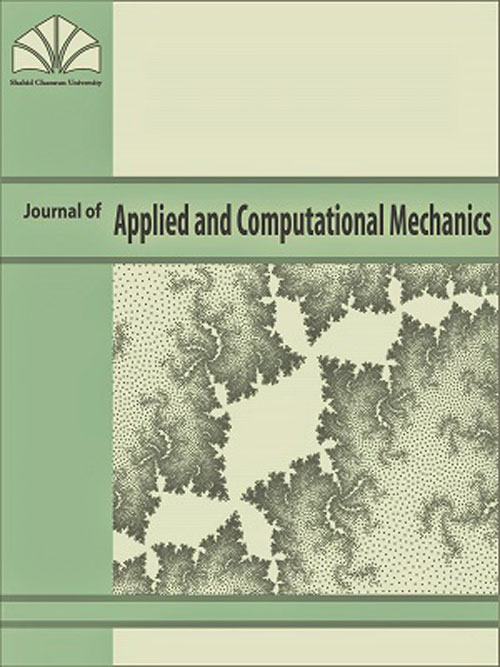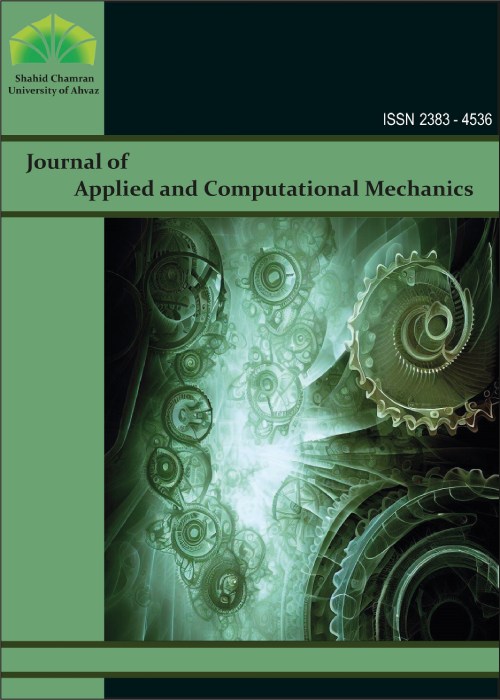فهرست مطالب

Journal of Applied and Computational Mechanics
Volume:2 Issue: 1, Winter 2016
- تاریخ انتشار: 1394/12/25
- تعداد عناوین: 6
-
-
Pages 1-7Among the intermolecular interactions, the Casimir and van der Waals forces are the most important forces that highly affect the behavior of nanostructures. This paper studies the effect of such forces on the adhesion of cantilever freestanding nanostructures. The nanostructures are made of a freestanding nano-beam which is suspended between two upper and lower conductive surfaces. The linear spring model is applied to derive the elastic force. The Lumped Parameter Model (LPM) is used to obtain constitutive equations of the systems. The maximum length of the nano-beam which prevents the adhesion is computed. Results of this study are useful for design and development of miniature devices.Keywords: Adhesion, Casimir force, Van der Waals force, Freestanding nano, beam, Lumped Parameter Model (LPM)
-
Pages 8-20The presence of van der Waals (vdW) force can lead to mechanical instability in freestanding nano-scale actuators. Most of the previous researches in this area have exclusively focused on modeling the instability in actuators with one actuating components. While, less attention has been paid to actuators consist of two actuating components. Herein, the effect of the vdW force on the instability of freestanding actuators with two parallel actuating components is investigated. Conventional configurations including cantilever and double-clamped geometries are investigated. A continuum mechanics theory in conjunction with Euler-beam model is applied to obtain governing equations of the systems. The nonlinear governing equations of the actuators are solved using two different approaches, i.e. the modified Adomian decomposition and the finite difference method. The maximum length of the nanowire and minimum initial gap which prevents the instability is computed.Keywords: Freestanding nanoactuators, van der Waals (vdW) force, instability, modified Adomian decomposition, finite difference method
-
Pages 21-28This paper presents the Jeffery Hamel flow of a non-Newtonian fluid namely Casson fluid. Suitable similarity transform is applied to reduce governing nonlinear partial differential equations to a much simpler ordinary differential equation. Variation of Parameters Method (VPM) is then employed to solve resulting equation. Same problem is solved numerical by using Runge-Kutta order 4 method. A comparison between both the solutions is carried out to check the efficiency of VPM. Effects of emerging parameters are demonstrated both for diverging and converging channels using graphical simulation.Keywords: Jeffery_Hamel flow_Casson fluid_Variation of Parameters Method (VPM)_converging_diverging channels_Runge_Kutta order 4 method
-
Pages 29-34In this paper, a new analytical approach has been presented for solving strongly nonlinear oscillator problems. Iteration perturbation method leads us to high accurate solution. Two different high nonlinear examples are also presented to show the application and accuracy of the presented method. The results are compared with analytical methods and with the numerical solution using Runge-Kutta method in different figures. It has been shown that the iteration perturbation approach doesnt need any small perturbation and is accurate for nonlinear oscillator equations.Keywords: Periodic solution_Nonlinear oscillators_Motion of a rigid rod rocking back_Tapered beams
-
Pages 35-41Duffing harmonic oscillator is a common model for nonlinear phenomena in science and engineering. This paper presents He´s Energy Balance Method (EBM) for solving nonlinear differential equations. Two strong nonlinear cases have been studied analytically. Analytical results of the EBM are compared with the solutions obtained by using He´s Frequency Amplitude Formulation (FAF) and numerical solutions using Runge-Kutta method. The results show the presented method is potentially to solve high nonlinear oscillator equations.Keywords: Energy balance method, Nonlinear oscillator, Duffing, harmonic oscillator, Periodic solutions
-
Pages 42-53The BEM is applied to the solution of the torsion problem of non-homogeneous anisotropic non-circular prismatic bars. The problem is formulated in terms of the warping function. This formulation leads to a second order partial differential equation with variable coefficients, subjected to a generalized Neumann type boundary condition. The problem is solved using the Analog Equation Method (AEM). According to this method, the governing equation is replaced by a Poissons equation subjected to a fictitious source under the same boundary condition. The fictitious load is established using the Boundary Element Method (BEM) after expanding it into a finite series of radial basis functions. The method has all the advantages of the pure BEM, since the discretization and integration are limited only on to the boundary. Numerical examples are presented which illustrate the efficiency and accuracy of the method.Keywords: Anisotropic materials, Non, homogeneous media, Elasticity, Bars, Torsion


